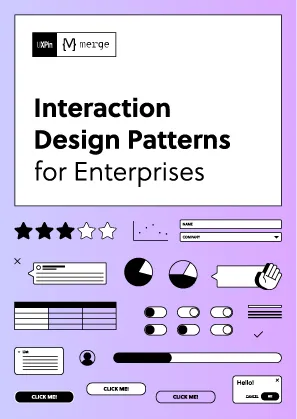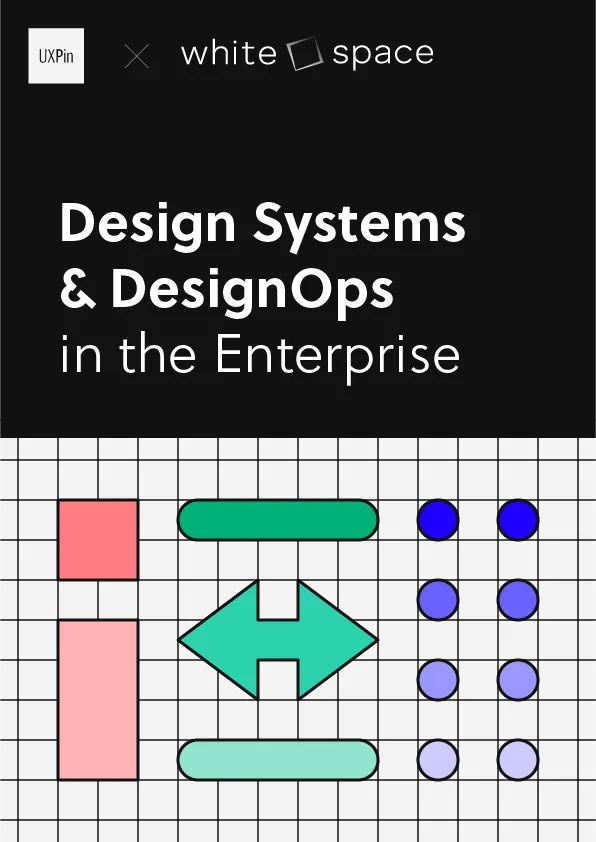Customizing a design pattern library can streamline workflows, save time, and improve collaboration between designers and developers. Here’s what you need to know:
- Why Customize? Tailored libraries align with brand identity, save up to 50% of engineering time, and meet specific project needs.
- Preparation Steps: Conduct a project needs analysis, review existing components for updates, and identify missing elements.
- Key Tools: Use design tools like UXPin Merge for code-backed components, version control for tracking changes, and clear documentation for team alignment.
- Customization Process:
- Adjust existing patterns for consistency.
- Build new components for gaps.
- Test for usability, accessibility, and performance.
- Implementation Tips: Integrate the library into workflows, train your team, and schedule regular updates to keep it relevant.
Quick Tip: Regularly review and update your library to ensure it evolves with your project needs. A well-maintained library can save significant time and resources.
Table of Contents
Design Systems, Pattern Libraries & Style Guides… Oh My!

Before You Start
Before diving into customization, it’s crucial to evaluate your project’s needs. This step helps you identify gaps and opportunities, ensuring your design strategy aligns with the library’s customization.
Project Needs Analysis
Conducting a thorough needs analysis is the foundation for customizing your library effectively. As Mark Figueiredo, Sr. UX Team Lead at T.RowePrice, puts it, "Understanding user needs and aligning them with project goals is essential for creating a design pattern library that truly serves its purpose."
Here’s how to approach the analysis:
| Analysis Area | Key Considerations | Expected Outcome |
|---|---|---|
| User Research | Interviews, behavior patterns, pain points | Clear understanding of user requirements |
| Technical Requirements | Platform compatibility, performance, accessibility | Document outlining constraints |
| Business Goals | Brand guidelines, KPIs, timeline constraints | Framework for strategic alignment |
Studies show that defining project needs upfront can cut design time by up to 30%, saving significant resources by reducing unnecessary iterations.
Component Review
Take a close look at the components you already have. This review should focus on their practicality and how they align with current and future needs.
Key areas to examine include:
- Usage Frequency: How often components are used in projects.
- Maintenance History: Patterns of updates or recurring issues.
- Technical Debt: Outdated code or design patterns that need attention.
- Accessibility Compliance: Ensure components meet WCAG standards.
These insights will help you identify which components need updates or replacements.
"When I used UXPin Merge, our engineering time was reduced by around 50%. Imagine how much money that saves across an enterprise-level organization with dozens of designers and hundreds of engineers." – Larry Sawyer, Lead UX Designer
Missing Elements Check
To ensure your library is comprehensive, compare it with industry benchmarks, competitor libraries, and user feedback. Regular reviews and prototyping tools can help you validate any gaps before development begins.
A gap analysis framework that considers both current needs and future scalability will help you avoid roadblocks. This approach ensures your library stays relevant as project requirements evolve.
Setting Up Your Workspace
Once you’ve assessed your project needs, it’s time to set up a workspace that simplifies design pattern customization and boosts efficiency.
Tool Selection
Choose tools that bridge the gap between design and development while supporting teamwork. Here’s a quick overview:
| Tool Category | Key Features | Advantages |
|---|---|---|
| Design & Prototyping | Code-backed components, version control | Saves engineering time, ensures consistency |
| Version Control | Git integration, branch management | Tracks changes, avoids conflicts |
| Documentation | API documentation, style guides | Aligns teams, eases onboarding |
Tools like UXPin make this process smoother by offering code-backed prototyping to integrate design and development workflows.
Team Collaboration Setup
For effective teamwork, focus on building a system that encourages transparency and real-time communication. This includes:
- A centralized component repository
- Clear and consistent naming conventions
- Shared access protocols for all team members
- Channels for real-time feedback and updates
"What used to take days to gather feedback now takes hours. Add in the time we’ve saved from not emailing back-and-forth and manually redlining, and we’ve probably shaved months off timelines." – Mark Figueiredo from T.RowePrice
After setting up these basics, ensure you have processes in place to maintain and protect these collaboration improvements.
Change Management System
To keep your workspace running smoothly, establish a structured approach to managing changes.
1. Version Control Protocol
Define a clear process for tracking updates. This includes using consistent commit messages, branch naming conventions, and merge guidelines.
2. Documentation Framework
Keep detailed records of:
- Component specifications
- Guidelines for usage
- Modification history
- Approval workflows
3. Review Process
Schedule regular review cycles, assigning specific roles and responsibilities to stakeholders for efficient feedback and decision-making.
"When I used UXPin Merge, our engineering time was reduced by around 50%. Imagine how much money that saves across an enterprise-level organization with dozens of designers and hundreds of engineers." – Larry Sawyer, Lead UX Designer
sbb-itb-f6354c6
4 Steps to Customize Design Patterns
These steps help align your design library with specific project needs while ensuring consistency and efficiency.
Adjust Existing Patterns
Update current patterns to match project requirements without compromising design consistency. Stick to your design language throughout the process.
Key areas to focus on:
- Component Analysis: Review your existing components and note what modifications are needed to ensure they integrate smoothly.
- Visual Consistency: Maintain cohesive design by following clear rules for updates. Here’s a breakdown:
| Aspect | Consideration | Implementation |
|---|---|---|
| Style Updates | Color, typography, spacing | Apply systematic changes across components |
| Functionality | Interaction patterns, states | Ensure consistent behavior |
| Documentation | Usage guidelines, examples | Update documentation to reflect changes |
- Technical Implementation: Use your design tools to make real-time updates to patterns while ensuring the underlying code remains consistent.
Once adjustments are complete, move on to creating new components to address any gaps in your design system.
Build New Patterns
After refining existing patterns, focus on building new components to meet additional requirements.
- Pattern Framework: Define use cases, component specifications, acceptance criteria, and testing parameters before starting development.
- Development Process: Build each component carefully to ensure quality and consistency.
"As a full stack design team, UXPin Merge is our primary tool when designing user experiences. We have fully integrated our custom-built React Design System and can design with our coded components." – Brian Demchak, Sr. UX Designer at AAA Digital & Creative Services
Test and Improve
Testing is crucial to validate your customized patterns. Companies that incorporate user feedback report a 34% increase in satisfaction and engagement.
Here’s how to approach testing:
-
Usability Testing: Focus on areas like:
- User interaction patterns
- Performance metrics
- Accessibility compliance
- Cross-platform compatibility
- Feedback Integration: Use the following framework:
| Phase | Action | Outcome |
|---|---|---|
| Collection | Gather user feedback and testing data | Identify pattern effectiveness |
| Analysis | Review performance metrics | Determine necessary adjustments |
| Implementation | Apply validated changes | Improve pattern usability |
| Validation | Verify improvements | Ensure changes meet requirements |
- Continuous Improvement: Keep monitoring how patterns perform and collect feedback regularly. Document successful updates and their impacts to guide future enhancements.
Using Your Custom Library
Add to Current Workflow
Integrating your custom library into your existing process can improve team efficiency. Teams using UXPin Merge, for instance, have reported better workflows thanks to code-based integration.
- System Integration: Link your library with your current design and development tools. For teams leveraging code-based design systems, platforms like UXPin Merge allow smooth integration with React components, ensuring alignment between design and development.
- Workflow Adjustment:
| Phase | Documentation Requirements | Implementation Guidelines |
|---|---|---|
| Design | Component specifications, usage rules | Define when and how to use each pattern |
| Development | Technical requirements, API documentation | Provide code examples and integration steps |
| QA | Testing parameters, acceptance criteria | Detail validation procedures |
Once integrated, focus on equipping your team with the knowledge and skills for consistent application.
Team Training Guide
Proper training is key to ensuring your team uses the library effectively. A structured program can help maintain consistency across teams.
Key Training Elements:
- Host hands-on workshops and regular review sessions
- Share detailed documentation and video tutorials
- Pair new team members with experienced mentors
- Track recurring challenges and document solutions
"Regular training and hands-on practice are essential for ensuring that team members can effectively utilize and maintain a design pattern library." – Jane Doe, UX Design Expert, UXPin
Update Schedule
Regular updates are crucial for keeping your library relevant and functional:
Quarterly Reviews
- Analyze how patterns are being used
- Check component performance
- Revise documentation based on team feedback
Version Control
- Log all updates in a centralized system
- Share changes through team communication channels
- Archive outdated components
| Timeline | Action Items | Stakeholders |
|---|---|---|
| Weekly | Fix bugs, make minor improvements | Development team |
| Monthly | Review pattern usage | Design leads |
| Quarterly | Add major updates or new patterns | Entire team |
| Annually | Conduct a full library audit | Leadership, team leads |
Conclusion
Main Points
Customizing design pattern libraries takes thoughtful planning and precise execution. It involves understanding project needs, fostering team collaboration, and committing to ongoing updates. Companies like AAA Digital & Creative Services have shown how integrating custom React Design Systems with modern tools can improve workflows and boost team productivity.
Here are some key factors to focus on:
| Factor | Impact | Best Practice |
|---|---|---|
| Needs Analysis | Sets the foundation | Review components thoroughly |
| Tool Integration | Boosts workflow | Use platforms with code-backed prototyping |
| Team Collaboration | Ensures consistency | Maintain clear communication channels |
| Regular Updates | Supports sustainability | Schedule quarterly reviews |
Getting Started
To begin, align your steps with your team’s skills and your project goals. As Senior UX Team Lead Mark Figueiredo from T.RowePrice explains:
"What used to take days to gather feedback now takes hours. Add in the time we’ve saved from not emailing back-and-forth and manually redlining, and we’ve probably shaved months off timelines."
Follow these practical steps to customize your design library:
- Conduct a detailed analysis of your project needs.
- Choose tools that support code-backed components.
- Set up a system for managing changes effectively.
Companies that use modern design tools for their custom pattern libraries report better workflows and higher productivity. Code-backed design systems have proven their worth for teams aiming to streamline their design and development processes.

